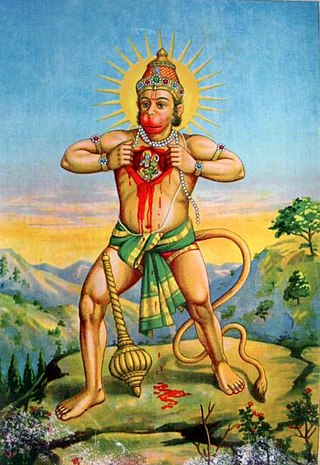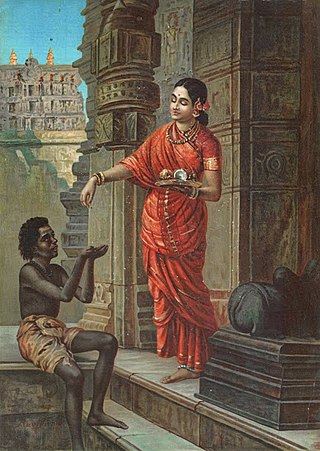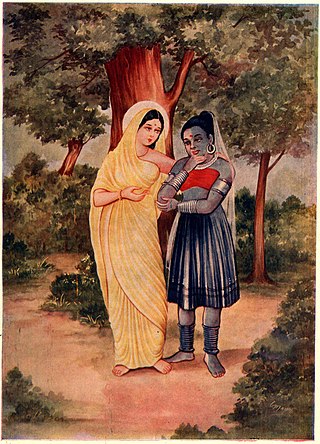Related Research Articles

The Ramayana is a smriti text from ancient India, one of the two important epics of Hinduism known as the Itihasas, the other being the Mahabharata. The epic, traditionally ascribed to the Maharishi Valmiki, narrates the life of Rama, a prince of Ayodhya in the kingdom of Kosala. The epic follows his fourteen-year exile to the forest urged by his father King Dasharatha, on the request of Rama's stepmother Kaikeyi; his travels across forests in the Indian subcontinent with his wife Sita and brother Lakshmana; the kidnapping of Sita by Ravana, the king of Lanka, that resulted in war; and Rama's eventual return to Ayodhya along with Sita to be crowned king amidst jubilation and celebration.

Hanuman, also known as Maruti, Bajrangabali, and Anjaneya, is a deity in Hinduism, revered as an avatar of Shiva, divine vanara, and a devoted companion of the deity Rama. Central to the Ramayana, Hanuman is celebrated for his unwavering devotion to Rama and is considered a chiranjivi. He is traditionally believed to be the spiritual offspring of the wind deity Vayu, who is said to have played a significant role in his birth. His tales are recounted not only in the Ramayana but also in the Mahabharata and various Puranas.

In Hinduism, Vanara are either monkeys, apes, or a race of forest-dwelling people.

Ramcharitmanas, is an epic poem in the Awadhi language, based on the Ramayana, and composed by the 16th-century Indian bhakti poet Tulsidas. This work is also called, in popular parlance, Tulsi Ramayana, Tulsikrit Ramayana, Tulsidas Ramayana or simply Manas. The word Ramcharitmanas literally means "Lake of the deeds of Rama". It is considered one of the greatest works of Hindu literature. The work has variously been acclaimed as "the living sum of Indian culture", "the tallest tree in the magic garden of medieval Indian poetry", "the greatest book of all devotional literature" and "the best and most trustworthy guide to the popular living faith of the Indian people".

Mandodari was the queen consort of Ravana, the king of Lanka, according to the Hindu epic Ramayana. The Ramayana describes her as beautiful, pious, and righteous. She is extolled as one of the Panchakanya, the recital of whose names is believed to dispel sin.

Sita, also known as Siya, Janaki, Maithili, Vaidehi and Bhumija, is a Hindu goddess and the female protagonist of the Hindu epic, Ramayana. She is the consort of Rama, the avatar of the god Vishnu, and is regarded as a form of Vishnu's consort, Lakshmi. She is also the chief goddess of Rama-centric Hindu traditions. Sita is known for her dedication, self-sacrifice, courage, and purity.

Sundara Kanda is the fifth book in the Hindu epic Ramayana. The original Sundara Kanda is in Sanskrit, and was composed in popular tradition by Valmiki, who was the first to scripturally record the Ramayana. Sundara Kanda is the only chapter of the Ramayana in which the principal protagonist is not Rama, but Hanuman. The work depicts the adventures of Hanuman and his selflessness, strength, and devotion to Rama are emphasised in the text. Hanuman is believed to have been fondly called “Sundara” by his mother Anjana, and Sage Valmiki is stated to have chosen this name over others as the Sundara Kanda is about Hanuman's journey to Lanka.

Alathiyur Hanuman Temple, also known as Alathiyur Perumthrikkovil or Hanuman Kavu is a famous Hindu temple located between the Ponnani River and the Bharathappuzha at Alathiyur near Tirur, Malappuram district, Kerala state, India. Although the main deity is Rama, the seventh avatar of Vishnu, Hanuman, believed to be an incarnation of Shiva and a devotee of Rama and a Chiranjivi, is as famous as the main deity in the temple. Also reside in the temple as sub-deities of equal importance: Lakshmana, Ganesha, Maha Vishnu, Durga, Bhadrakali, Ayyappan, and Naga deities. According to legend, the idol of Hanuman was consecrated 3000 years ago by Sage Vasishtha, one of the Saptarishis. Over the years, the custodians of the temple were the Alathiyur village Nambudiri Clan, the King of Vettathunad, and the Samuthiri of Kozhikode. Aval is the main offering in this temple. The main annual event here is the festival held on the days corresponding with the Stars of of Pooradam, Uthradam and Thiruvonam in the month of Thulam corresponding to mid-October to mid-November. The month of Karkidakam, corresponding to mid-July and mid-August, popularly called the Ramayana month, is usually crowded. The weekdays of Tuesday, Thursday and Saturday are also important as they are considered auspicious for Hanuman. The temple is administered by a Trust under the Malabar Devaswom Board, with the Samuthiri royalty as the Chief Trustee. This is believed to be the most important temple among the temples under the administration of the Malabar Devaswom Board.

Pampa Sarovara is a lake in Koppal district near Hampi in Karnataka. To the south of the Tungabhadra River, it is considered sacred by Hindus and is one of the five sacred sarovars, or lakes in India. According to Hindu theology, there are five sacred lakes; collectively called Panch Sarovar; Mansarovar, Bindu Sarovar, Narayan Sarovar, Pampa Sarovar and Pushkar Sarovar. They are also mentioned in Shrimad Bhagavata Purana. In Hindu scriptures Pampa Sarovar is regarded as the place where Pampa, a form of Shiva's consort Parvati, performed penance to show her devotion to Shiva. It is also one of the Sarovar's that finds a mention in the Hindu epic, Ramayana as the place where Shabari, a devotee of Rama waited for the arrival of Ram.

Ashoka Vatika is a grove in Lanka that is located in the kingdom of the rakshasa king Ravana. It is mentioned in the Vishnu Purana and the Hindu epic Ramayana of Valmiki, and all subsequent versions, including the Ramacharitamanas written by Tulsidas, where it finds mention in the Sundara Kanda. The Vatika has garden houses around it, built by Vishvakarma himself.

Bhṛṅgadūtam (2004), literally The bumblebee messenger, is a Sanskrit minor poem (Khaṇḍakāvya) of the Dūtakāvya (messenger-poem) genre composed by Jagadguru Rambhadracharya (1950–). The poem consists of 501 verses in the Mandākrāntā metre divided in two parts. Set in the context of the Kiṣkindhākāṇḍa of Rāmāyaṇa, the poem describes the message sent via a bumblebee by Rāma, spending the four months of the rainy season on the Pravarṣaṇa mountain in Kiṣkindhā, to Sītā, held captive by Rāvaṇa in Laṅkā.

Lanka Dahan is a 1917 Indian silent film directed by Dadasaheb Phalke. Phalke also wrote the film based on an episode of the Hindu epic Ramayana, credited to Valmiki. The film was Phalke's second feature film after the 1913 Raja Harishchandra, which was the first Indian full-length feature film. Phalke also directed various short films in between.
Ramleela – Ajay Devgn Ke Saath, commonly known as Ramleela is a mythological on-stage musical drama, based on the famous Indian epic poem Ramayan. The show premiered on 21 October 2012 on Life OK and completed the story in five episodes on 18 November 2012. The show was narrated by Bollywood actor Ajay Devgn, who provided a prologue at the beginning of each episode or act. The show aired during the period from Dussehra in October till Diwali in November.

In some adaptations of the Hindu epic Ramayana, Maya Sita or Chaya Sita is the illusionary duplicate of the goddess Sita, who is abducted by the demon-king Ravana of Lanka instead of the real Sita.

Trijata is a rakshasi (demoness) in the Hindu epic Ramayana who is assigned the duty of guarding Sita who was kidnapped by the demon-king of Lanka Ravana. In later adaptions of Ramayana, Trijata is described as a daughter of Vibhishana, the brother of Ravana.

In the Hindu epic Ramayana, Sarama is the wife of Vibhishana, the brother of Ravana, the demon (rakshasa) king of Lanka. Sometimes, she is described as a rakshasi (demoness), at other times, she is said to have gandharva lineage. All accounts agree that Sarama was friendly to Sita, the consort of Rama, who was kidnapped by Ravana and imprisoned in Lanka. Like her husband who sides with Rama in the war against Ravana, Sarama is kind to Sita and aids Rama. Sarama and Vibhishana had a daughter called Trijata.

In the Hindu epic Ramayana, Nala, is the vanara (monkey), who is credited as the engineer of the Rama Setu, a bridge across the ocean between Rameswaram and Lanka, identified with modern-day Sri Lanka, so forces of the god Rama can pass over to Lanka. The bridge is also known as Nala Setu, the bridge of Nala. Along with Nala, another vanara who is his twin brother called Nila is also credited as the builder of the bridge. Nala is described as the architect of the vanaras. He is described as the son of the architect-god Vishwakarma. Nala is also described to have fought in the battle between Rama and Ravana, the king of Lanka.

Nila, also spelled as Neela, is a character in the Hindu epic Ramayana. He is a vanara chieftain in the army of Rama, the prince of Ayodhya and avatar of the god Vishnu. He is the commander-in-chief of the vanara army under the vanara king Sugriva, and is described as leading the army in Rama's battle against the rakshasa king Ravana of Lanka and as killing many rakshasas.

Surasa also Siras is a Hindu goddess, who is described as the mother of the nagas (serpents). Her most popular tale appears in the Hindu epic Ramayana, where she is tasked to test the god Hanuman on his way to Lanka.